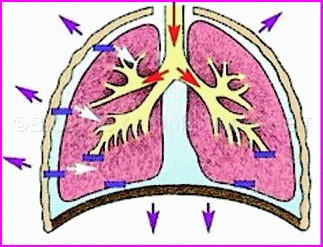Physiology related pages:
- Physiology
- Human Organ System
- Blood
- Red blood cells
- Hemoglobin
- Blood Clotting Process
- Blood Group Types
- Rh Factor
- Blood Pressure
- Normal white blood cell count
- Lymphatic System
- Nervous System
- The Spinal Cord
- Nervous System Function
- Structure of Neuron
- Synapse
- Cranial Nerves
- Autonomic Nervous System
- Endocrine System
- Hormones
- Classification of Hormones
- Pituitary Gland Hormones
- Posterior Pituitary Hormones
- Function of Thyroid Hormone
- Gastrointestinal Hormones
- Where is the Pancreas
- Pancreas Function
- Growth Hormone Deficiency
- Adrenal Cortex
- Enzymes
- Vitamin
- Fat Soluble Vitamins
- Water Soluble Vitamins
- Folic Acid and Vitamin C
- Minerals for the body
- Essential Minerals for the body
- Amino Acids
- Classification of Proteins
- Protein Function
- Protein Properties
- Types of Fatty Acids
- Lipids
- Lipid Classification
- Respiratory System
- Mechanism of Breathing
- Respiratory System Disorders
- Cardiovascular System
- Immunology
- Immune System
- Human muscles
- Properties of Muscles
- Skeletal Muscle
- Muscle contraction
- Heart Muscle
- Smooth Muscle
- BMR
- BMR Measurement
- Bone Joint
- Mouth Cavity
- Male Reproductive System
- Human Urine
- Abnormal constituents of urine
- Sweat Glands
- Mental Illness
- Digestion of carbohydrates
- Protein Digestion
What is breathing?
Breathing is an external manifestation of respiration and is characterized by movements of chest and abdomen. By observing the thoracic and abdominal movements it can be easily under stood that the man is respiring. We shall now go for a discussion about the mechanism of breathing of the human being.
Phases of breathing:
The breathing is divisible into two phases; those are - (i) inspiration and (ii) expiration. Whereas the inspiration is the breathing in or inhalation and the expiration is the breathing out or exhalation.
During the inspiration, the thoracic cavity and the lungs expand and the air drawn into the lungs, whereas during expiration the chest cavity and the lungs decrease in the volume and the air is expelled from the lungs. The breathing continues to occur throughout the life. The breathing is quite and smooth under normal conditions, when inspiration and expiration occur spontaneously and rhythmically. Though in some situations of emergency breathing may be forced or driven by will power.
In normal adult man, the breathing rate at rest is about 12 to 20 per minute. So in normal Mechanism of breathing the inspiration and as well as expiration occur 12 to 20 times in a minute. In children the breathing rate is higher and it becomes higher during muscular exercise for any normal person.
Breathing Mechanism :
The increase and decrease of the thoracic cavity during inspiration and expiration are the main mechanism of breathing. Because these process are brought about by contraction and relaxation of certain voluntary muscles that are referred to as respiratory muscle. The diaphragm and intercostals muscle are called primary respiratory muscles because they are required for normal as well as forced breathing.
The diaphragm is a dome shaped muscular sheet which separates thorax and abdomen in mammals. When the muscles of diaphragm contract, it is pulled down towards abdomen, so that the thoracic cavity increases in vertical dimension and at the same time the wall of the abdomen is bulged out due to the increased pressure within it. In between the adjacent ribs the intercostals muscles are situated. It is known to us that there are 12 ribs on either side of the chest and naturally there are 11 sets of intercostals muscles on each side of the chest. When these muscles contract, the rib-cage moves upward and forward. Due to these movements the thoracic cavity increases in antero-posterior and lateral dimensions.
Inspiration:
During the inspiration process of normal gentle breathing, both diaphragm and intercostals muscles contract so that the thoracic cavity expands in all dimensions. As a consequence of this, the lungs also expand because they are attached to the inner wall of the thorax by pleura. This in turn reduces the pressure within the lungs below the level of the atmosphere. Thus the air is drawn into the lungs from the atmosphere and inspiration is completed.Expiration:
After this, expiration occurs by a reverse process to that of inspiration. During expiration, the thoracic cavity is reduced due to the diaphragm and intercostals muscles relax and returning to their original position. This raises the intrapulmonary pressure above the atmospheric level and as a result the air is expelled out from the lungs through the respiratory tract. After normal inspiration or expiration, the intrapulmonary pressure is equal to the atmospheric pressure.Interestingly, it is noticeable that during quiet inspiration or expiration of chest cavity is brought about by contraction of muscles which is an energy consuming process; hence, the normal inspiration is an active process. Otherwise the normal expiration is a passive process, because during normal expiration the chest cavity is reduced by relaxation of muscles which does not require expenditure of energy.
Normal inspiration and expiratory movements is the mechanism of breathing which occur spontaneously and rhythmically. This is not due to an inherent rhythm-city of the respiratory muscle indeed. Rhythmic breathing is maintained by the activity of the respiratory centers present in Pons and medulla region of brain which manage the respiratory muscles.



